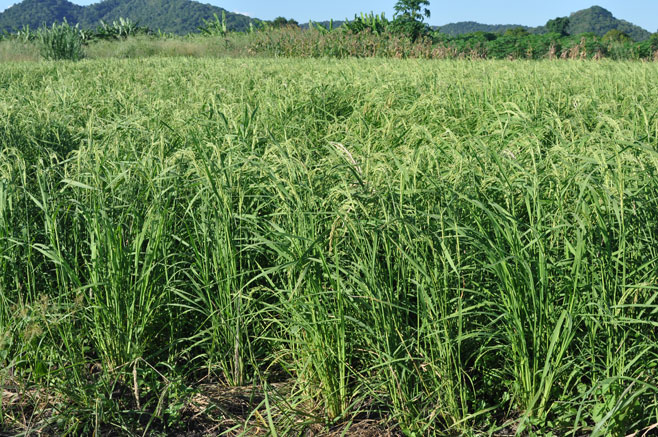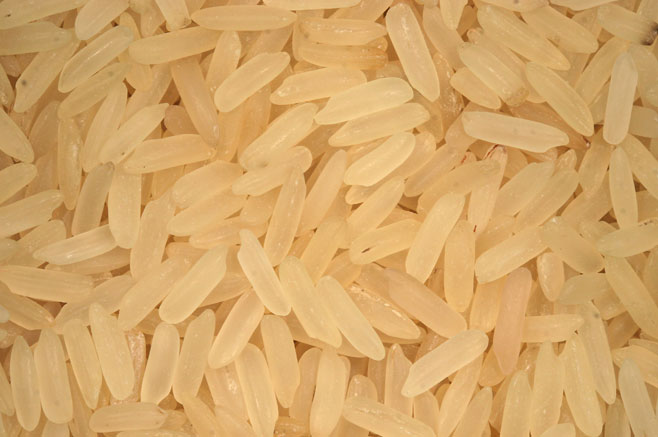Oryza sativa (Rice) rys [Afrikaans]; reise [N Sotho, Sesotho]; reisi
[Tswana]; irayisi [Xhosa, Zulu] Life
> eukaryotes >
Archaeoplastida >
Chloroplastida
>
Charophyta > Streptophytina > Plantae (land plants)
> Tracheophyta (vascular plants) > Euphyllophyta > Lignophyta (woody plants)
> Spermatophyta (seed plants) > Angiospermae (flowering
plants) > Monocotyledons > Order: Poales
> Family: Poaceae > Genus:
Oryza
 |
|
Oryza sativa under cultivation at Cuacua,
Mozambique. [photo John E. Burrows ©] |
 |
|
Rice grains. [photo
H.G.
Robertson, Iziko ©] |
Rice was domesticated in Asia at least 7000 years ago.
Over 90% of world rice production is in Asia where the monsoon rains favour
paddy rice, which needs to grow in wet conditions. Rice is a staple food among many people in southern Africa
but is derived almost exclusively from Asian imports and is rarely grown in this
region. In Asia, rice is not only used in eating but also used for making
alcoholic drinks such as saki in Japan.
Domestication
Rice was domesticated separately in West Africa (Oryza
glaberrima) and Southeast Asia (Oryza sativa) but it was the latter
region that gave rise to the rice we eat today. Oryza sativa is a
domesticated species that orginated mainly from selective breeding of the wild
annual species Oryza nivara but with some interbreeding with the wild
perennial species Oryza rufipogon. As is the case with all cereals,
domestication involved selecting seeds that were retained on the plant
('non-shattering'). In cultivating rice plants, those that retained their seeds
were automatically selected because the seeds were not lost.
Many races of rice have been produced but the main group
of races are the paddy or wet rice races that grow in water. The dry rices or
hill rices originated secondarily from the paddy rices. While paddy rice is
highly productive, and can give two harvests in a single season, it demands a
lot of attention and historians have drawn a connection between the development
over thousands of years of systems for managing irrigation and labour, and
the strict social discipline that is often associated with people from
Asia.
It is difficult to date when domestication of rice took
place because little in the way of seed remains have been found in Asian
archaeological sites. There is evidence of swamp agriculture beginning in about
7000 BC in New Guinea but the earliest record of domesticated rice grains in an
archaeological site is from eastern China, dating to about 5000 BC. This site is
outside the natural distribution of the wild rice ancestors. By 2000 BC rice was
widespread across northern India. The present-day situation is that over 90% of
the world's rice crop is grown in Asia, so this cereal has not spread worldwide
as widely as other cereal crops such as wheat, mainly because of its need for
wet conditions, which are best provided in the monsoon regions. The huge
populations of people that exist in Asia are sustained mainly by wet rice cultivation.
Madagascar is a major rice-growing region and this dates back to the the first
millenium AD when it was colonised by people from the Sumatran vicinity.
Productivity from rice plants has been increased through
major selective breeding and hybridization intiatives. There are over 8000
varieties of rice. Indian rice is long-grained, dry, flaky and easily
separated when cooked. Japanese rice is short grained, moist, firm and sticky
when cooked. The stickiness arises from the fact that it contains a higher
proportion of amylopectin, which are waxy starch molecules
Rice is milled to different degrees, depending on the
product desired. The more milled it is, the less nutritious it becomes:
- Brown rice. The outer husk (hull) is removed leaving
the intact kernel covered by bran layers.
- Unpolished rice. The bran layer and most of the germ is
removed using an abrasive process.
- Polished rice. The aleurone layer, which has a
high fat content is removed, using a wire brush machine. Removal of this
layer increases the storage life of the grain because fats tend to go
rancid. Nutrients are often added to polished rice by applying a vitamin
solution to the outer layer, coating it with a protein powder and drying
it. .
Rice is a staple food among many people in southern Africa
but is derived almost exclusively from Asian imports and is rarely grown in this
region. In Asia, rice is not only used in eating but also used for making
alcoholic drinks such as saki in Japan.
Publications
-
Anon. 2002. Encyclopedia of Foods. A Guide
to Healthy Nutrition. Academic Press, San Diego, California.
-
McGee, H. 1991 (first published 1984). On
Food and Cooking. The Science and Lore of the Kitchen. Harper Collins,
London.
-
Sauer, J.D. 1993. Historical geography of
crop plants - a select roster. CRC Press, Boca Raton, Florida.
Text by Hamish Robertson |
